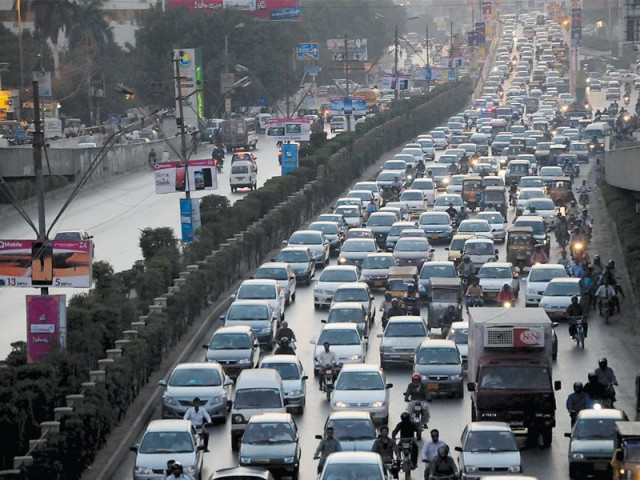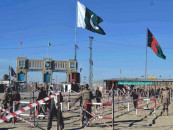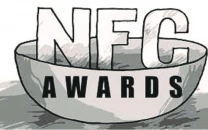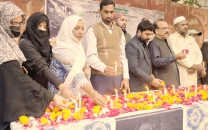Star Gate to Steel Mills: A black hole for traffic
Congestion study launch timed with start of KMC’s work on Malir Halt, 15 flyovers.

“This traffic congestion affects us all,” said Indus Motors CEO Parvez Ghias when his turn came to speak. “We’ve accepted it as our daily routine.” PHOTO: FILE
“This traffic congestion affects us all,” said Indus Motors CEO Parvez Ghias when his turn came to speak. “We’ve accepted it as our daily routine.”
This is why two years ago, Toyota Indus Motors decided to help pay for research by NED’s department of urban and infrastructure engineering into how much traffic congestion was costing Karachi. They picked one of the busiest routes: Star Gate on Sharae Faisal to Pakistan Steel Mills. They found that it came to Rs10 million a day if they considered going slower than 40km/hr a delay. This factors in opportunity cost, vehicle operating cost and wear and tear.
This 20-km strip was chosen because it has nine intersections and is part of a highway that leads to Hyderabad and is fed by industries in Landhi and Bin Qasim. There are a lot of accidents on it.
They tracked the traffic with laser guns and specially fitted vehicles. This was supplemented by 600 survey forms which looked at the people, their type, how much they earned, why they used this road and how long they got stuck on it. This was buttressed by interviews with staff at 17 industries along the way. This helped establish the main stakeholders for this stretch of road used by a variety of people and goods and commercial trucks, trailers, motorcycles, chingqis. “[There is a difference between] when a CEO travels, when a labourer travels,” explained principal investigator NED’s Dr Mir Shabbar Ali. And thus the cost is different if they get stuck in traffic. “If you spend one hour in a traffic jam, you will be useless by the time you reach office.”

Star Gate to Pakistan Steel Mill intersections
17mins is how long it should take to travel this stretch with no obstructions (free flow travel time) but it actually takes over 30mins
60% of traffic on this stretch is private cars and motorcycles but heavy vehicles rise in number from Quaidabad to Steel Mill
50,000 vehicles per day per direction travel on this stretch on average
Star Gate
Worst strip: Star Gate to Malir 15 faces 77% of
traffic delays
Malir 15
Malir 15 Intersection (encroachment, bad traffic management) costs Rs750,000 per day
Railway Crossing
Railway Crossing access point, manual traffic management costs Rs200,000 per day.
Oil Tanker near Port Qasim (encroachment, lane blocking) costs Rs900,000 per day.
Ganchi Market (encroachment) costs Rs80,000 per day
Malir River bridge
Malir River bridge (expansion joint) Rs60,000 per day
Manzil Pump
Avoid: Manzil pump because the oil tanker parking depot delays traffic here 150% Cost: Rs5.6m per day for this stretch
....................................................................................................................................................
They found that the total average delay on this stretch is largely taking place in the urban (40% of the strip) and not the industrial area (60% of the strip). This is caused by bottlenecks, bad traffic control or signals, illegal parking and delays in the signals. The worst spot in the industrial area is where illegal parking of oil tankers leads to distress at Manzil Pump. The tankers were relocated here from Shireen Jinnah Colony. They found that Malir Halt is used by pedestrians during the day which has a direct effect on motorised traffic. Encroachment at Malir 15 was about 30% of the problem.
If there were a free flow of traffic from Star Gate intersection to the Steel Mills intersection it would take 17 minutes to traverse. But in reality if you are going at 40km/hour, it takes more than 30 minutes on average — double the time.
The study factors in fuel consumption as cost as well. So for example, a car’s is Rs1.75 per minute for petrol but a truck’s is Rs7.5 per minute for diesel. Idling cars in traffic jams are bad for pollution.
“These studies don’t even begin to touch the environmental cost,” said Ghias. The idea is, however, to at least put something out there that reaches stakeholders and provokes decision-makers. “If you work for the Japanese they say, ‘In God we trust, everyone else bring data’.”
Dr Muhammad Adnan shared the findings which looked at the cost under normal conditions, when oil tankers were involved and during Ramzan timings. According to him, if there are no vehicles on the road, you can still only reach a speed of just 70km/hr because the road’s surface condition isn’t good. The strip was designed for 100km/hr speeds.
Solutions?
The previous vice-chairman at Indus Motors spoke to the Japanese International Cooperation Agency to see how they could help. They saw the Malir section as the biggest choke point and proposed a flyover, which the city government is building now. In fact, the launch of the congestion report was timed to go with the city government’s foundation-stone laying ceremony for the flyovers at Malir Halt and Malir 15. They will become the city’s 40th and 41st flyovers.

If flyovers are being torn down globally and replaced by mass transit, why press the city government to build more? And isn’t Indus Motors helping put more cars on the roads, which is a problem for Karachi in the first place? Ghias countered this by saying that Indus Motors was interested in finding solutions but at the end of the day the responsibility did lie with the city’s planners. Reducing industrial output was not the answer. Actually, the problem is that Karachi’s road network has not kept up with expansion.
Dr Shabbar added that he felt that people’s mindset needed to change first. If BRTS were started in Karachi tomorrow would the rich abandon their cars and send their children to school on it? “Are we mentally prepared to take BRTS?” Perhaps a trip to Lahore might persuade him.
Average speed km/hr
Car 50
Taxi 45
Office Van 42
Three Wheeler 28
Bike 40
Public Transport 29
Truck 26
Average 40
Facts
1.3 million is the number of vehicles registered in Karachi - almost half of the Pakistan’s total.
9% is the annual increase in private vehicle (mainly cars and motorcycles) ownership with 300 vehicles added to the roads of Karachi every day.
Rs0.11m per day per km is the cost of traffic congestion.
From 8:30am to 9:30am over 2,500 vehicles flowed and in the evening over 3,500.
The average delay during peak hours was 20 mins per trip.
Malir Halt to Kalaboard has the highest number of vehicles per hour at 3,999
The value of time in India is US$0.75, in Bangladesh $0.72 and in Pakistan $0.7. Japan’s is $21.
Published in The Express Tribune, January 31st, 2014.



















COMMENTS
Comments are moderated and generally will be posted if they are on-topic and not abusive.
For more information, please see our Comments FAQ